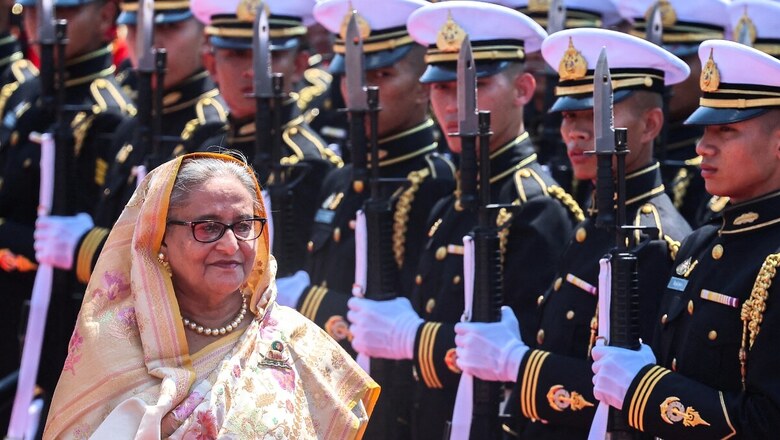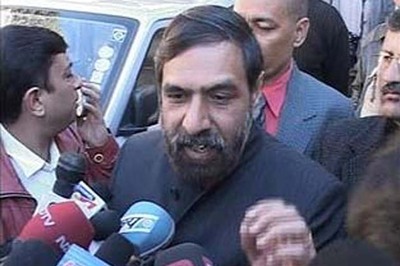
views
Amid violent protests in Bangladesh, reports say Sheikh Hasina, the country’s Prime Minister has resigned and fled. This comes as protesters took to streets demanding her resignation, with the death toll reaching 100 in the violence that shook the nation.
“She and her sister have left Ganabhaban (the Prime Minister’s official residence) for a safer place,” news agency AFP said quoting a source. “She wanted to record a speech. But she could not get an opportunity to do that,” the source said.
Bangladesh has been marred by protests and violence that began last month after student groups demanded scrapping of a controversial quota system in government jobs. Bangladeshis have been protesting against 30 per cent quota for government jobs given to families of the 1971 war veterans. Owing to violence, the Supreme Court had decided to reduce the quota to 5 per cent. However, that didn’t help end the protests.
For Sheikh Hasina, who has been the Prime Minister of Bangladesh for five terms, this comes a huge jolt.
Sheikh Hasina’s Rise in Politics
Hasina comes from a political background. Born to Sheikh Mujibur Rahman, the principal orchestrator of Bangladesh’s independence, Hasina has been at the forefront of the movement for democracy in Bangladesh.
Hasina along with other members of her family was detained briefly in 1971 for her participation in an uprising during the war. On August 15, 1975, Hasina’s father, mother, and three brothers were assassinated in their home by several military officers. Hasina, who was out of the country then, spent six years in exile.
It was at this time that she was elected to the leadership of the Awami League, the largest political organisation of Bangladesh founded by her father.
In 1981, Hasina returned to Bangladesh and became an advocate of democracy, seeing herself embroiled by controversies and protests several times. After becoming the leader of the opposition in the Bangladesh parliament, Hasina spoke out against military rule and initiated measures to secure human rights for all citizens.
In December 1990, the last military leader of Bangladesh, Lt Gen Hussain Mohammad Ershad resigned after an ultimatum issued by Hasina.
In 1991, Bangladesh saw its first free general election in 16 years but Hasina failed to obtain a majority. Following this, Hasina and her supporters accused opponent Khaleda Zia, leader of the rival Bangladesh Nationalist Party (BNP), of dishonesty during the election, and boycotted the parliament.
This sparked violence in the country, leading to a political turmoil, and ultimately leading to a caretaker government taking over, before Hasina was elected prime minister in June 1996.
Why Sheikh Hasina Was Seen as ‘Authoritarian’ Than ‘Democratic’
Ever since Hasina took over as the Prime Minister of Bangladesh, her rule has witnessed protests by the Opposition that often turned violent. In 2001, Opposition leader Khaleda-led alliance defeated Hasina, with the Awami League yet again claiming that the results had been fixed, but this time, they could not overthrow the Khaleda government.
In 2007, Hasina was arrested on charges of extortion, alleged to have taken place during her tenure as prime minister while Khaleda was arrested on charges of corruption. This was when the military-backed interim government had declared a state of emergency. Both the leaders were imprisoned, and released from jail in 2008.
Later that year, when the state of emergency was lifted, Hasina won the general elections that were held on December 29. In 2010, the Hasina government set up the first tribunal to begin trying war crimes cases from the 1971 war. Many of those convicted by the tribunal were influential members of the Awami League’s opposition, and the tribunal came to be called politically motivated by protesters.
Hasina and her party faced accusations of suppressing the opposition throughout their term in power. Many opposition members were arrested or tried. Jamaat-e-Islami, party key to the opposition coalition, was banned in 2013 from participating in elections, after a court ruled that its religious charter was inconsistent with Bangladesh’s secular constitution.
Hasina was also accused of suppressing the opposition ahead of the January 2024 general elections. According to the BNP, more than 20,000 of its leaders, members, and supporters were arrested since October 2023.
Hasina, however, promised a “free and fair” election, and led her party to a landslide victory with the Awami League winning 222 seats in the 300-seat Jatiya Sangsad.
What Led to Sheikh Hasina’s Resignation?
In 1972, Hasina’s father Sheikh Mujibur Rahman had introduced a 30 per cent quota in civil service and public sector jobs for the descendants of those who participated in 1971 war free the country from Pakistan.
However, in October 2018, Hasina had agreed to abolish all reservation amid protests. This changed in June this year, when the High Court nullified that decision and reinstated the quotas.
This led to the recent protests, as students questioned why the third generation of freedom fighters was being provided benefits, besides demanding a total merit-based recruitment. Even as the Supreme Court reduced the quota, the protests had flared up and had become a movement against the Sheikh Hasina government on several issues, leading to the Awami League leader fleeing the country and stepping down.
Catch the latest developments on Bangladesh’s political unrest in our live blog.




















Comments
0 comment